Services on Demand
Journal
Article
Indicators
-
 Cited by SciELO
Cited by SciELO -
 Access statistics
Access statistics
Related links
-
 Cited by Google
Cited by Google -
 Similars in
SciELO
Similars in
SciELO -
 Similars in Google
Similars in Google
Share
Colombian Journal of Anestesiology
Print version ISSN 0120-3347
Rev. colomb. anestesiol. vol.39 no.1 Bogotá Jan./Mar. 2011
https://doi.org/10.5554/rca.v39i1.75
Reporte de Caso
Orthotopic Liver Transplant in a Patient With Hemophilia A
Oswaldo Amaya*, Juan Andrés Cuervo**, Fernando Raffan***, Fabián Manrique****, Sergio Martínez*****
* Médico anestesiólogo intensivista cardiovascular y de trasplantes, Departamento de Anestesiología del Hospital Universitario Fundación Santa Fe de Bogotá. Profesor asistente de la Universidad El Bosque y de la Universidad de los Andes. Bogotá. Colombia.
** Médico anestesiólogo general y de trasplantes, Departamento de Anestesiología del Hospital Universitario Fundación Santa Fe de Bogotá. Bogotá, Colombia.
*** Anestesiólogo general y de trasplantes, intensivista, Departamento de Anestesiología del Hospital Universitario Fundación Santa Fe de Bogotá. Profesor asociado de Anestesiología de la Universidad El Bosque y profesor de cátedra de la Universidad de los Andes. Bogotá, Colombia, raffanmago@hotmail.com
**** Médico residente de anestesiología de II año, Departamento Anestesiología del Hospital Universitario Fundación Santa Fe de Bogotá, Universidad El Bosque. Bogotá, Colombia, fabianmanrique84@yahoo.com.
***** Residente de Anestesiología de I año, Departamento Anestesiología. Hospital Universitario Fundación Santa Fe de Bogotá, Universidad El Bosque. Bogotá, Colombia.
Recibido: julio 13 de 2010. Enviado para modificaciones: julio 21 de 2010. Aceptado: agosto 9 de 2010.
SUMMARY
Hemophilia is defined as a recessive hereditary trait linked to the X chromosome. It is characterized by a deficiency of several coagulation factors (hemophilia A: factor VIII, and hemophilia B: factor IX) Clinically, a person with hemophilia has spontaneous bleeding (mostly intra-articular) and the hemostatic control of it is difficult for which the intraoperative management of hemophiliac patients is challenging.
This case report describes a 62 year old patient with hemophilia A, who had a diagnosis of liver cirrhosis secondary to a hepatitis C infection. The patient developed a 22 mm hepatocarcinoma in segment VII of the liver and was successfully subjected to an orthotopic liver transplant at the University Hospital Fundación Santa Fe de Bogotá.
Keywords: Hemophilia A, Liver Transplantation, Trombelastography, Anesthesia, Hepatitis C. (Source: MeSH, NLM).
CASE REPORT
He was a 62 year old male patient who had a mild hemophilia A without inhibitors, diagnosed 35 years ago with a liver cirrhosis Child A, and MELD 22, secondary to a chronic hepatitis C and a 22 cm hepatocarcinoma in segment VI. A pretransplantation assessment was performed at the University Hospital Fundación Santa Fe de Bogotá where it was approved in a Decision Committee and was accepted to the transplantation waiting list for five months.
His previous medical history included high blood pressure, hypothyroidism, total hip replacement five years earlier, blood type O negative, and liver cirrhosis secondary to hepatitis C.
The physical exam showed a blood pressure of 125/67 mmHg, heart rate of 67/min and a respiratory rate of 16/min without any signs of encephalopathy, ascites or jaundice.
Preoperative testing showed elevated liver function tests (AST: 152, ALT: 120), a PTT 41.3 sec vs. 27.1 sec of control, normal PT, and factor VIII activity of 33%. Renal function tests, electrolytes, complete blood count, alkaline phosphatase, fibrinogen, chest X ray, electrocardiogram and arterial blood gases (ABGs), were all within normal values (Table 1).
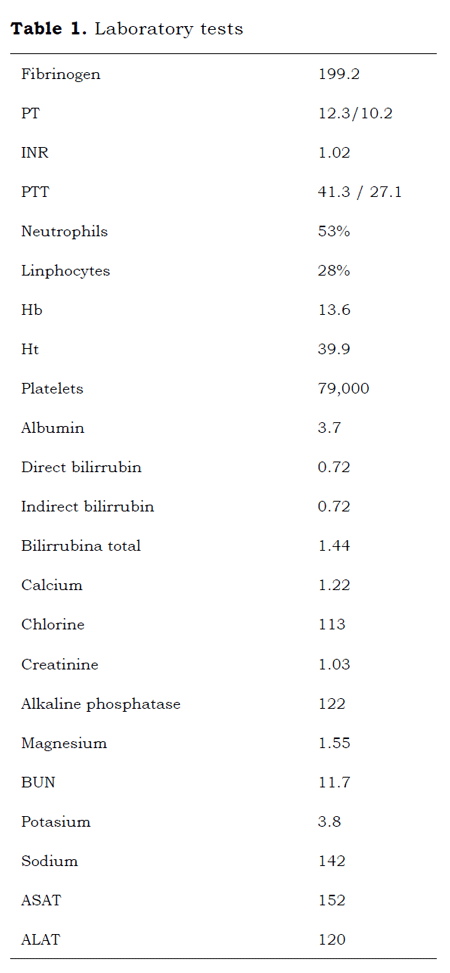
The patient had an orthotopic liver transplant performed using the piggyback technique, lateral caval-cavostomy with a cold ischemic duration of 4 hours and 15 minutes, and warm ischemia of 52 minutes. Among the intraoperative findings were a small cirrhotic liver without metastatic disease and mild portal hypertension.
ANESTHESTIC MANAGEMENT
Preoperatively, 60U per kg of Factor VIII were administered as the initial management to achieve a 100% theoretical activity (1). Once Factor VIII was administered, and under ecographic guidance (2) a three lumen central venous catheter was inserted in the left internal jugular vein, and a Swan Ganz sheath was inserted in the right internal jugular vein. A left radial arterial catheter, a rapid infusion system in the upper right arm, an Entropy monitor, electrocardiographic leads DII and V5, pulse oximeter, a Foley catheter and a nasal temperature probe were inserted.
The anesthetic technique consisted of: an intravenous induction with midazolam 2 mg, sodium thiopental 300 mg, muscle relaxation with cisatracurium 10 mg, orotracheal intubation with atraumatic bougie in a size 8 orotracheal tube; maintenance with fentanyl 5 mcg/kg/h and a mixture of air, oxygen and isoflurane at 1.5 %, and an intravenous infusion of factor VIII at 5 U/kg/h.
PROCEDURE
After a bolus of 1750 U (60 U/kg) of factor VIII, and a continuous infusion of 400U/hr, the surgical procedure was begun with normal ABGs and thromboelastogram (TEG) (Figure 1). Postinfusion titration of Factor VIII activity was of 102.2 %, whereas the hemoglobin and hematocrit were 10.5 g/dl and 31 % respectively.
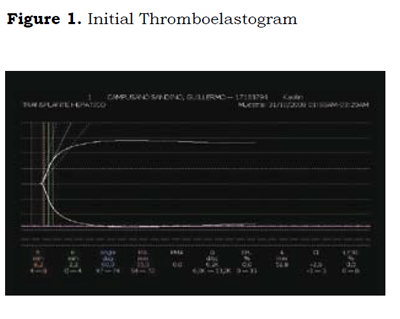
Three hours later. a calcium infusion was started at 5 ml/hr, and at the fourth hour of surgery during the liver resection there was active bleeding with a hypotensive trend for which noradrenaline was started at 0.1 mcg/kg/min and another bolus of 20 U/kg of Factor VIII was administered along with surgical hemostasis, with which blood pressure and hemostasis were restored. In the anhepatic phase and with proper hemodynamic stability, a new titration of Factor VIII reported 132.7 % activity, normal ABGs, and a blood glucose of 134 mg/dl, a hemoglobin of 9.2 g/dl and a hematocrit of 27 %, with a good TEG tracing (Figure 2).
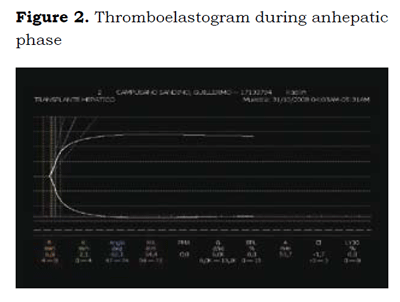
After 5 hours of surgery and during the phase of reperfusion the norepinephrine drip was suspended and dopamine was started at a rate of 4 |ug per kilo per minute. Because of a trend towards hypertension, new ABGs and a thromboelastrogram were performed which showed no abnormality (Figure 3).
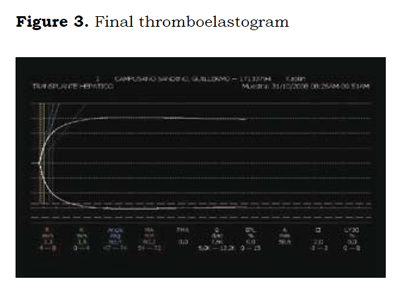
The procedure lasted for 7 hours after which the patient was transferred to the ICU under a dopamine drip of 4 µg per kilo per minute, with a total of 5000 mL of fluid administered, 2500 mL of colloids, 9 units of packed red blood cells, 11 units of fresh frozen plasma, 1 platelet apheresis, with an estimated blood loss of 2000 mL, diuresis of 3 mL per kilo per hour, stable vital signs, a thromboelastogram showing no dynamic abnormality of coagulation, and ABGs showing a pH of 7.32, PaO2 of 101 mmHg, PCO2 of 32.6 mmHg, sodium of 148 mEq per liter, potassium of 3.9 mEq per liter, a hematocrit of 20 %, and a hemoglobin of 6.8 g/dL.
In the postoperative period the patient received infusions of factor VIII at a rate of 30 units per hour every 8 hours maintaining levels above 100 % of factor activity during the 1st 24 hours. For this reason that dosage was decreased and 36 hours postoperatively, the infusion was discontinued with an activity of factor VIII persisting above 80 % during his whole hospital stay (3,4) (Figure 4).
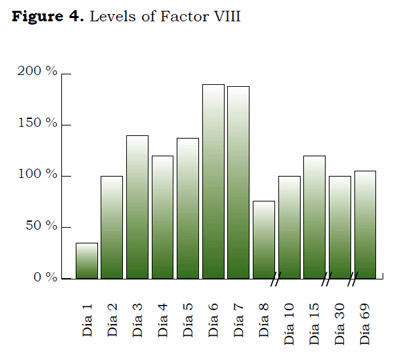
The patient stayed in the ICU for 8 days because he developed a pneumonia which was difficult to manage. Thereafter, he had a hospital stay of 17 days in in the ward. His hemostatic activity was never compromised and his hepatic function was satisfactory.
DISCUSSION AND CONCLUSIONS
Currently, the key to managing hemophiliacs is the appropriate administration of factor VIII (1,2), which was a treatment developed in the 1980s, and in Colombia in the 1990s. Any hemophiliac born before this time probably received treatment with blood products which did not have viral inactivation techniques and therefore have a higher rate of infectious microorganisms. Today, hemophilia is still considered as a risk factor for infection with microorganisms carried in these blood products.
Most hemophiliacs treated before the 80s (the 90s in Colombia) have been infected with the hepatitis C virus (HCV). HCV infections are responsible for 30 % of the hepatic cirrhosis that need as treatment a liver transplant (5).
Since 1969, it is known that the definite cure for a person with hemophilia is a liver transplantation, since factor VIII and IX are produced in the liver. Therefore, hemophiliac patients who require liver transplants are really cured from both hemophilia and cirrhosis (5,6).
In this case, a favorable clinical outcome with good function of the transplanted liver maintained factor VIII in optimal levels in the next few months without the need of intravenous infusions.
The thromboelastogram is an computerized device that measures the viscoelastic properties of the blood in a dynamic and global way as it shows the integration of platelets with the coagulation cascade. The TEG has demonstrated to be a very useful tool in the management and monitoring of patients with coagulopathy and has great advantage over classical coagulation tests (PT, PTT, INR), as it includes the interaction of cellular and plasmatic coagulation factors (7,8). The immediate availability of intraoperative results permits to monitor the presence or absence of therapeutic effects, which in our case facilitated the management during surgery and allowed the verification of the therapeutic effects of the infusion of factor VIII, plasma and platelets for which it was very useful for the anesthetic management (3,5,9).
In the preanesthetic assessment of the hemophiliac patient it is necessary to obtain information regarding bleeding (frequency, severity, duration, management), as well as transfusion history, infectious diseases and the presence of inhibitors (4,6).
It is recommended to have a previous assessment by hematology to optimize the level of the factors before surgery, to confirm the availability of the factor and the hospital pharmacy, and to ensure that biosafety measures are applied (8,10,11).
REFERENCES
1. Caicedo MV, Raffan F y Duarte M. Manejo perioperatorio del paciente hemofílico. Rev Mex Anestesiol. 2009;32(3):177-185.
2. Raffan F, García M, Celis, E, Chaves A, Ramírez F, Díaz J. Algoritmo de práctica clínica basado en la evidencia para el uso de ultrasonido en la colocación de catéteres venosos centrales. Rev Colomb Anestesiol. 2005;33(1):51-8.
3. Féray C, Caccamo L, Alexander GJ, Ducot B, Gug-enheim J, Casanovas T, et al. European collaborative study on factors influencing outcome after liver transplantation for hepatitis C. European Concerted Action on Viral Hepatitis (EUROHEP) Group. Gastroenterology. 1999;117(3):619-25.
4. McCarthy M, Gane E, Pereira S, Tibbs CJ, Heaton N, Rela M, et al. Liver transplantation for haemophiliacs with hepatitis C cirrhosis. Gut. 1996; 39(6):8705.
5. Lake JR, Shorr JS, Steffen BJ, Chu AH, Gordon RD, Wiesner RH. Differential effects of donor age in liver transplant recipients infected with hepatitis B, hepatitis C and without viral hepatitis. Am J Transplantation. 2005;5(3):549-57.
6. Tatsumi K, Ohashi K, Shima M, Nakajima Y, Okano T, Yoshioka A. Therapeutic effects of hepatocyte transplantation on hemophilia B. Transplantation. 2008; 86(1):167-70.
7. Raffan F, Ramírez F, Cuervo J, Sánchez L. Tromboelastografía. Rev Colomb Anestesiol. 2005;33(1):181-6.
8. De Pietria L, et al. Use of recombinant factor IX and thromboelastography in a patient with hemophilia B undergoing liver transplantation: a case report. Transplantations Proceedings. 2008; 40(6):2077-9.
9. Berenguer M, Loópez-Labrador FX, Wright TI. Hepatitis C and liver transplantation. J Hepatol. 2002;35:666-78.
10. Clavien P, Petrowsky H, De Oliveira M, Graf R. Strategies for safer liver surgery and partial liver transplantation. N Engl J Med.2007;356(15):1545-59.
11. Middleton PF, Duffield M, Lynch SV, Padbury RT, House T, Stanton P, et al. Living donor liver transplantation-adult donor outcomes: a systematic review. Liver Transpl. 2006;12(1):24-30.
Conflicto de intereses: ninguno declarado
1. Caicedo MV, Raffan F y Duarte M. Manejo perioperatorio del paciente hemofílico. Rev Mex Anestesiol. 2009;32(3):177-185. [ Links ]
2. Raffan F, García M, Celis, E, Chaves A, Ramírez F, Díaz J. Algoritmo de práctica clínica basado en la evidencia para el uso de ultrasonido en la colocación de catéteres venosos centrales. Rev Colomb Anestesiol. 2005;33(1):51-8. [ Links ]
3. Féray C, Caccamo L, Alexander GJ, Ducot B, Gug-enheim J, Casanovas T, et al. European collaborative study on factors influencing outcome after liver transplantation for hepatitis C. European Concerted Action on Viral Hepatitis (EUROHEP) Group. Gastroenterology. 1999;117(3):619-25. [ Links ]
4. McCarthy M, Gane E, Pereira S, Tibbs CJ, Heaton N, Rela M, et al. Liver transplantation for haemophiliacs with hepatitis C cirrhosis. Gut. 1996; 39(6):8705. [ Links ]
5. Lake JR, Shorr JS, Steffen BJ, Chu AH, Gordon RD, Wiesner RH. Differential effects of donor age in liver transplant recipients infected with hepatitis B, hepatitis C and without viral hepatitis. Am J Transplantation. 2005;5(3):549-57. [ Links ]
6. Tatsumi K, Ohashi K, Shima M, Nakajima Y, Okano T, Yoshioka A. Therapeutic effects of hepatocyte transplantation on hemophilia B. Transplantation. 2008; 86(1):167-70. [ Links ]
7. Raffan F, Ramírez F, Cuervo J, Sánchez L. Tromboelastografía. Rev Colomb Anestesiol. 2005;33(1):181-6. [ Links ]
8. De Pietria L, et al. Use of recombinant factor IX and thromboelastography in a patient with hemophilia B undergoing liver transplantation: a case report. Transplantations Proceedings. 2008; 40(6):2077-9. [ Links ]
9. Berenguer M, López-Labrador FX, Wright TI. Hepatitis C and liver transplantation. J Hepatol.2002 ;35 666-78. [ Links ]
10. Clavien P, Petrowsky H, De Oliveira M, Graf R. Strategies for safer liver surgery and partial liver transplantation. N Engl J Med.2007;356(15):1545-59. [ Links ]
11. Middleton PF, Duffield M, Lynch SV, Padbury RT, House T, Stanton P, et al. Living donor liver transplantation-adult donor outcomes: a systematic review. Liver Transpl. 2006;12(1):24-30. [ Links ]











 text in
text in 

